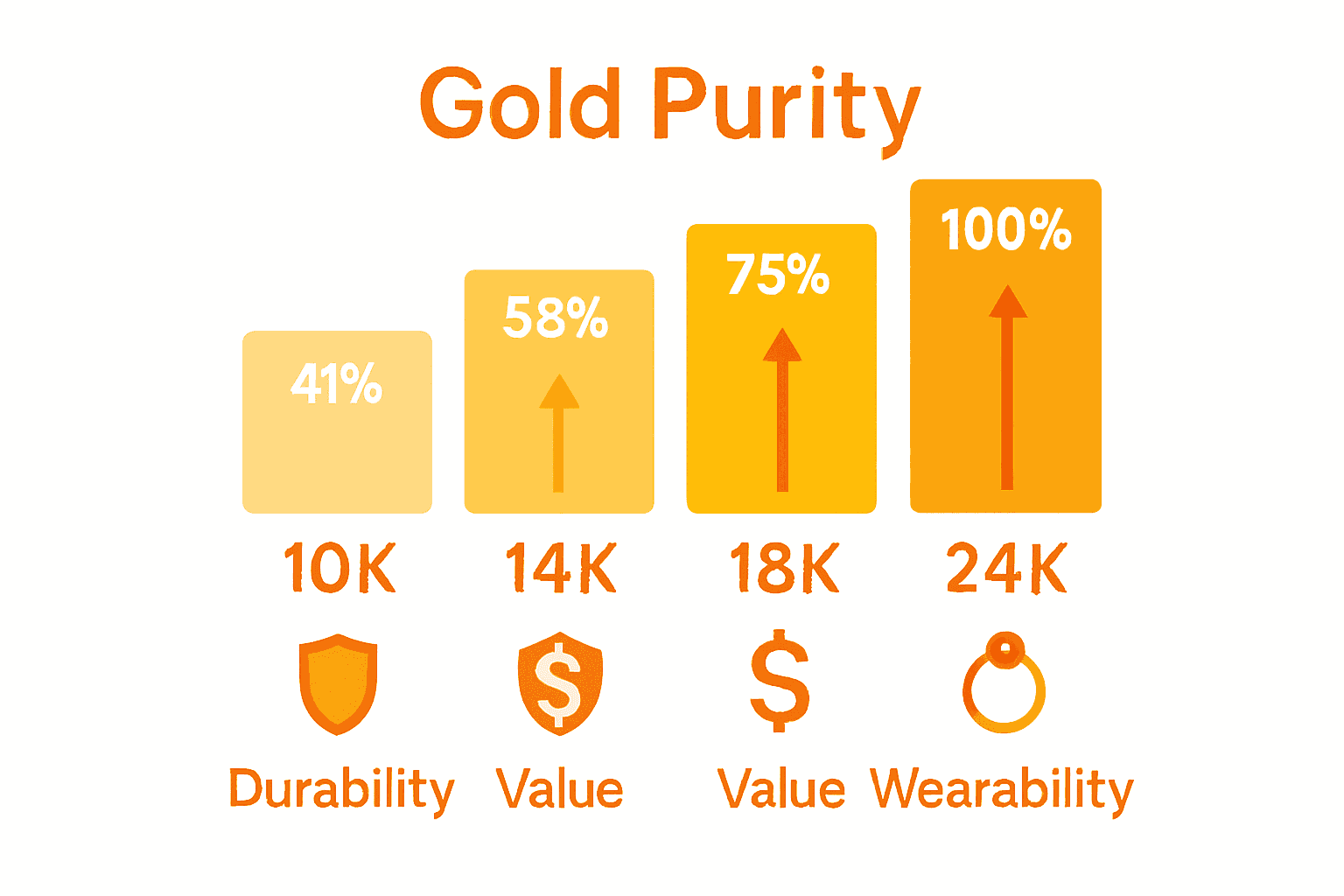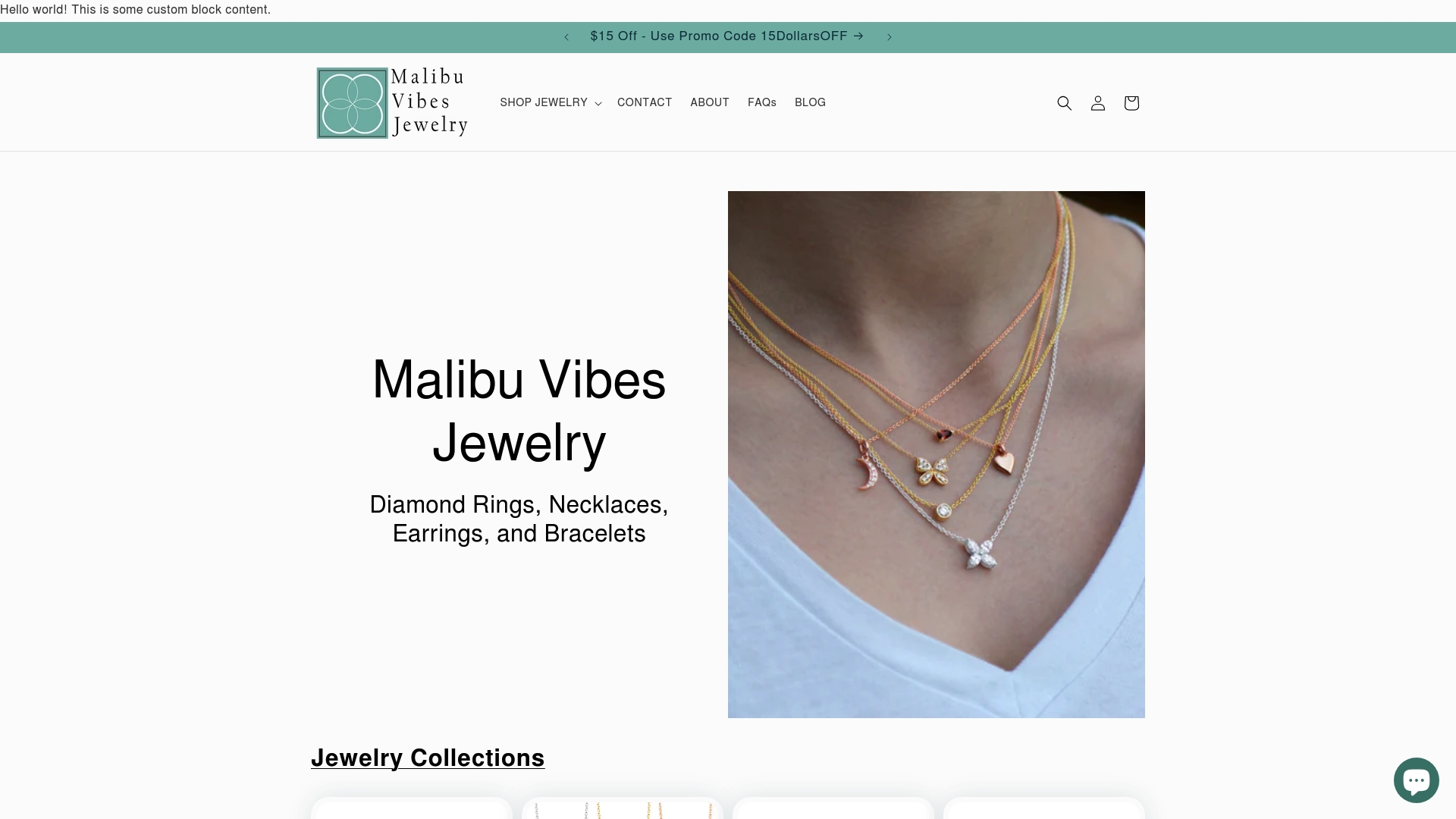Did you know that 24-karat gold is too soft for most jewelry even though it is the purest form available? Many shoppers believe higher karat means better quality, but the real story is far more interesting. Understanding the differences between gold karats can help you choose jewelry that not only looks stunning but also lasts. With so many myths circulating, learning what each karat level offers can save you money and disappointment.
Table of Contents
- Gold Karats Defined And Common Misconceptions
- Comparing 10k, 14k, 18k, And 24k Gold
- Purity, Color, And Durability By Karat
- Value, Price, And Resale Factors
- Choosing The Best Karat For Jewelry
Key Takeaways
| Point | Details |
|---|---|
| Gold Purity Measurement | Karats measure the percentage of pure gold, with 24k being 100% pure; however, higher karats do not always equal better jewelry durability. |
| Karat Characteristics | 10k, 14k, 18k, and 24k gold offer distinct balances of purity, color, and durability, making lower karats more practical for daily wear. |
| Value Factors | Gold jewelry value is influenced by gold content, weight, market conditions, and craftsmanship, affecting resale potential beyond simple purity. |
| Personal Selection | Choosing the ideal karat depends on individual lifestyle, aesthetic preference, and practical needs, with suggestions for use cases for each karat level. |
Gold Karats Defined and Common Misconceptions
Gold purity is a complex world where appearances can be deceiving. At its core, karats measure the percentage of pure gold in a piece of jewelry, with 24-karat representing 100% pure gold. According to the American Gem Society, pure gold is remarkably soft, which means jewelers often mix it with other metals to enhance durability and strength.
Contrary to popular belief, higher karat numbers don’t always mean better jewelry. While 24-karat gold sounds luxurious, it’s actually too malleable for everyday wear. Most fine jewelry ranges between 10 to 18 karats, strategically blending gold with metals like silver, copper, or zinc to create pieces that are both beautiful and resilient. For instance, our guide on understanding 14k gold explores how different metal compositions impact jewelry performance.
Common misconceptions about gold karats include:
- Thinking pure gold (24k) is ideal for all jewelry
- Believing higher karat always means higher quality
- Assuming all gold jewelry looks and performs the same
Understanding gold karats helps you make smarter purchasing decisions, ensuring your jewelry combines aesthetic appeal with practical wearability. When shopping, consider not just the karat rating, but how the specific metal composition suits your lifestyle and personal style.
Comparing 10k, 14k, 18k, and 24k Gold
Understanding the nuanced world of gold karats is crucial for making informed jewelry purchases. According to the American Gem Society, gold jewelry is categorized into four primary karat levels: 10k, 14k, 18k, and 24k, each representing a different percentage of pure gold content.
Gold Karat Breakdown:
- 24k Gold: 99.99% pure gold, richest color, most expensive, but extremely soft
- 18k Gold: 75% pure gold, softer and more vibrant than lower karats
- 14k Gold: 58.3% pure gold, the most popular for jewelry due to excellent durability
- 10k Gold: 41.7% pure gold, most affordable and most resistant to wear
When selecting gold jewelry, consider more than just aesthetic appeal. Understanding the differences between 14k and 18k gold reveals why 14k is often preferred for engagement rings and everyday pieces. Lower karat gold contains more alloy metals, making it harder and more scratch-resistant, while higher karat gold offers a deeper, more luxurious color but requires more delicate handling.
Your choice depends on personal style, budget, and lifestyle. Active individuals might prefer 10k or 14k for durability, while those seeking a more luxurious look might invest in 18k gold, understanding it requires more careful maintenance.

Purity, Color, and Durability by Karat
Gold’s character transforms dramatically as its purity changes, creating a fascinating interplay between color, strength, and value. According to the American Gem Society, pure gold’s inherent softness means that jewelers strategically blend metals to enhance its performance, resulting in variations that go far beyond simple aesthetic differences.
Color Variations by Karat:
- 24k Gold: Bright, rich yellow (purest color)
- 18k Gold: Deep yellow with slight softening of tone
- 14k Gold: Lighter yellow with noticeable metal alloy influence
- 10k Gold: Palest yellow, most significantly altered by additional metals
The metal composition doesn’t just impact color—it fundamentally changes durability. Discover the benefits of gold jewelry to understand why jewelers carefully balance purity and strength. Lower karat gold contains more robust metal alloys, making it more resistant to scratches and everyday wear, while higher karat gold offers a luxurious appearance at the cost of structural integrity.
Here’s a comparison of gold purity, color, and durability by karat:
| Karat Level | Gold Purity (%) | Typical Color | Durability |
|---|---|---|---|
| 24k | 99.99 | Bright yellow | Very soft |
| 18k | 75 | Deep yellow | Soft |
| 14k | 58.3 | Light yellow | Durable |
| 10k | 41.7 | Pale yellow | Most durable |
Ultimately, choosing the right gold karat is a personal decision balancing aesthetic preference, lifestyle demands, and budget. Whether you prioritize the rich color of high-karat gold or the practicality of more durable lower-karat pieces, understanding these nuanced differences empowers you to make an informed jewelry selection.

Value, Price, and Resale Factors
Understanding the economic landscape of gold jewelry requires more than just appreciating its aesthetic appeal. According to the American Gem Society, multiple factors converge to determine a piece’s financial worth, making gold jewelry a nuanced investment beyond its intrinsic beauty.
Key Value Determinants:
- Gold Content: Higher karat pieces command higher initial prices
- Weight: Heavier pieces typically have greater monetary value
- Market Conditions: Gold prices fluctuate based on global economic trends
- Craftsmanship: Unique design and expert manufacturing can increase value
While higher karat gold might seem like the most valuable option, understanding why invest in gold jewelry reveals a more complex picture. Resale value isn’t simply about gold percentage—durability, design, and market demand play crucial roles. A well-crafted 14k gold piece might ultimately retain more value than a more delicate 24k item.
Investors and jewelry enthusiasts should approach gold purchases as both emotional and financial decisions. The right piece balances aesthetic pleasure with potential long-term value, considering factors like craftsmanship, current market trends, and personal style preferences.
Choosing the Best Karat for Jewelry
Selecting the ideal gold karat is like choosing the perfect outfit—it’s all about matching your lifestyle, personal style, and practical needs. According to the American Gem Society, gold jewelry’s versatility means there’s no one-size-fits-all solution, but rather a strategic approach to finding your perfect match.
Karat Selection Guide:
- Engagement Rings & Daily Wear: 14k gold (best durability)
- Special Occasion Pieces: 18k gold (richer color, more luxurious)
- Delicate Jewelry: 10k gold (most scratch-resistant)
- Investment Pieces: 24k gold (highest pure gold content)
Understanding jewelry as an investment reveals that your choice goes beyond immediate aesthetics. Consider your daily activities, skin sensitivity, and budget. An active professional might prioritize 14k gold’s durability, while a collector might prefer the rich color of 18k pieces.
Ultimately, the best karat is the one that aligns with your personal narrative. Some people treasure a delicate 24k bracelet for special moments, while others prefer the resilience of 10k gold for everyday elegance. Your jewelry should not just accessorize—it should tell your unique story.
Discover Your Ideal Gold Karat with Malibu Vibes Jewelry
Choosing the perfect gold karat can feel overwhelming when faced with questions about purity, durability, and color. This guide has uncovered how different karats influence your jewelry’s look and wearability. Whether you prioritize the rich hue of 18k gold or the everyday strength of 14k, Malibu Vibes Jewelry offers handcrafted pieces designed to match your unique style and lifestyle without compromise.
Explore our stunning collection of Diamond & Gold Rings for Women crafted with expert care in 14k and 18k gold.

Elevate your jewelry experience today by choosing pieces that balance beauty and durability perfectly. Visit Malibu Vibes Jewelry and find your ideal match in our selection of solid gold necklaces, rings, and earrings. Don’t wait—enhance your everyday elegance now with jewelry made to last and delight.
Frequently Asked Questions
What are the different gold karats available in jewelry?
Gold jewelry commonly comes in four primary karats: 10k (41.7% pure gold), 14k (58.3% pure gold), 18k (75% pure gold), and 24k (99.99% pure gold).
How does gold purity affect the durability of jewelry?
Higher karat gold, like 18k and 24k, is softer and more malleable, making it less durable for everyday wear. In contrast, lower karat gold (10k and 14k) contains more alloy metals, which increase scratch resistance and durability.
What is the best gold karat for engagement rings?
14k gold is often recommended for engagement rings due to its excellent durability and balance of aesthetic appeal, making it suitable for daily wear.
How does gold color vary with different karat levels?
Gold color changes with purity: 24k gold is bright yellow, 18k gold has a deeper yellow hue, 14k gold is a lighter yellow influenced by alloys, and 10k gold appears paler due to higher alloy content.
Recommended
- Understanding the Difference Between 14k and 18k Gold – Malibu Vibes Jewelry
- What is 14k Gold? Understanding Its Beauty and Value – Malibu Vibes Jewelry
- What is Gold Filled Jewelry? Understanding Its Value – Malibu Vibes Jewelry
- Understanding Why Invest in Gold Jewelry: A Comprehensive Guide – Malibu Vibes Jewelry
- Unearthing the Truth About Gold in Granite
- Which Is Better? Gold-Filled vs. Gold-Plated Jewelry - Australian Opal Direct



